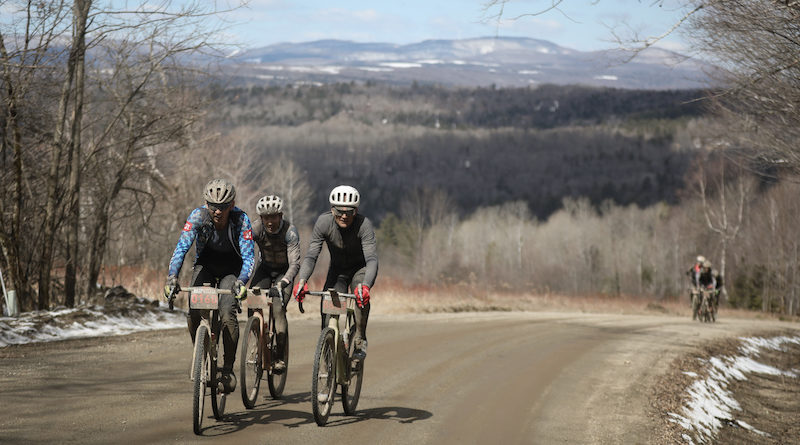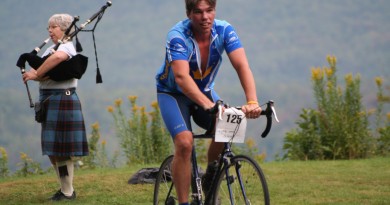For the Love of Mud, Snow & Gears
The strange saga of how a muddy gravel grinder in the Northeast Kingdom grew to become Vermont’s most popular race—and how one woman helped make it happen.
It was happening again. Ansel Dickey was hoping 2018 would be his chance to erase the bad memories of the 2017 Rasputitsa, a 40-mile gravel race that has become notorious for dragging cyclists across the Northeast Kingdom’s gnarliest dirt roads in the mud, snow and cold of April.
Everything was going well. With five miles to go, Dickey, a two-time winner from Woodstock, Vt., attacked the small group of leaders. On the eight-percent grade of Pinkham Road he dropped almost all of them. Then the true adventure began. A route marker had gone missing, so instead of turning left onto a dirt road to the finish, Dickey and a few other riders went straight onto a snow-packed cross-country ski trail. There were downed trees across the trail, and other trails splitting off in different directions. They had to dismount their bikes and trudge through the snow.
“Oh, God!” Dickey groaned to Ted King, a former World Tour rider. “Where are we?”
As they pushed their bikes up yet another hill, the motivation drained from Dickey’s body. He was not having fun anymore, and he just wanted to be done. It reminded him of the end of the previous year’s event, where he dropped out of the top three in the final 500 meters, which threw in cyclocross barriers and run-ups.
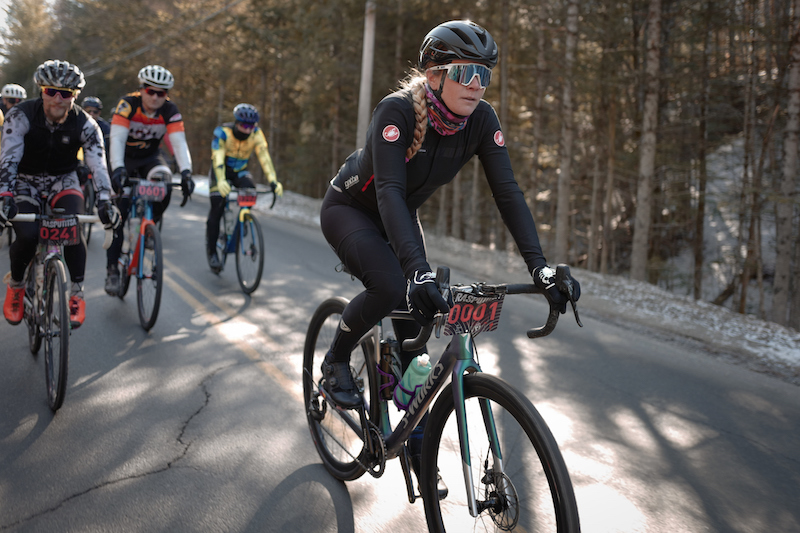
Kevin Bouchard-Hall, the 2002 New England Criterium champion, was having fun. He had been gapped on Pinkham Road, but he clawed his way back to Dickey and ran by him on the ski trail. He knew they were lost too, but didn’t much care. “I was like, screw it!” he recalled. “I’m going to keep running. We can complain and get down, or we can just keep jamming this adventure, and that’s what I did.”
The found the route and Bouchard-Hall went on to pass junior phenom Magnus Sheffield and pro cyclocross racer Anthony Clarke, and then ran his bike across the finish line at Burke Mountain in first place—because it was too snowy to ride.
Mud Season
If there’s one rule for approaching Rasputitsa—the Russian word for mud season—it’s to expect the unexpected. It is, after all, a 40-something-mile dirt-road bike race that takes place in Vermont’s Northeast Kingdom in April, when the roads can vary from dry gravel to sticky mud, to ice and snow—sometimes all in the same year.
That sense of the unknown has pervaded the race since its first edition, in 2014. Race founders Heidi Myers and Anthony Moccia mapped out the course during the winter, using online GPS software. A few weeks before the race, they went out to check the roads and realized that some of them were unmaintained public highways—Class IV roads, in Vermont parlance—and completely impassable. But they had already published the course, so they went with it. They called the toughest segment—a wet, icy river bed—“Cyberia” and tried to make it as fun as possible.
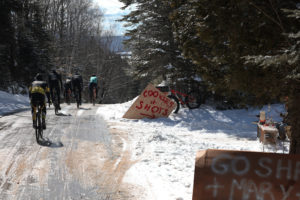
At the top of that slippery hike-a-bike section, they offered maple syrup shots in ice-cube shot glasses, and had a guy dressed up like a Yeti lurking in the woods. “We just tried to mask our complete ignorance,” Myers said. One rider came to the finish and told his wife he had seen a Yeti, and she just assumed he was hallucinating from hypothermia. “But in the end,” Moccia explained, “all the feedback we got from that section was positive, so it became one of the hallmarks of our course.”
Myers and Moccia are good friends who used to work together at Louis Garneau, the cycling apparel company, in Newport. They devised Rasputitsa as a way to bring tourism to the area and show off the Northeast Kingdom’s vast and beautiful network of back roads. Myers admired the famously punishing Paris-Roubaix race, a World Tour spring classic that traverses northern France’s cobblestone roads. She wanted to create an event with a similar feel in northern Vermont, where she grew up. But their race would have one major difference: it would ditch the nervous, hyper-competitive spirit of road racing and replace it with a welcoming, community-oriented atmosphere where people of all abilities could participate together. “We wanted the race to be about everybody, not just the winners,” Myers said.
It has proven a successful formula. The first edition of the race had 347 riders—a lot more than they expected—and this year’s race will have close to 1,500, making it the largest cycling race in the state. That’s because it attracts a wide swath of the bike riding public, from current and former pros such as Olympic mountain bike racers Lea Davison, Alison Tetrick, Anthony Clarke, Tim Johnson and Ted King, to beginners like Paul Izyk, a 54-year-old construction worker from Central New York who weighed 290 pounds the first time he entered, in 2016.

Brand new to cycling, Izyk first heard about Rasputitsa through social media. Intrigued, he asked his wife if she wanted to take a trip to Vermont in April. Shockingly, she said yes. “It was the first race I ever did, and I was hooked,” he said. Although he finished second from last, he beat his goal and enjoyed the grass-roots nature of the event, including the friendly volunteers and the local food. In his second year, he bested his previous time by 40 minutes. He praised the event so much to his friends at home that he convinced 15 of them to enter the following year. “Heidi and Anthony have become special friends,” he said. “I’m going to do this race every year until I can’t.”
While creating an event that new cyclists can tackle, Myers and Moccia have also worked hard to grow the female and under-23 audience. The registration fee for U-23 riders is almost nothing, and the organizers created a special women’s-only event in February to introduce women to the joy of backwoods riding. That event, Bittersweet, is what snagged Lisa Barton, 46, a former triathlete from Boston. She had tried Rasputitsa once and dropped out at the bottom of Cyberia. The following year, she was invited to Bittersweet with 50 other women. “It was minus-nine degrees, and we put on every layer we had and went fatbiking,” Barton said. “I had never been on a fatbike before. It was a crazy adventure, and none of it made sense to me, and then suddenly it did. A little switch flipped in my brain. Triathlon is over. I’m only going to ride my bike from now on.”
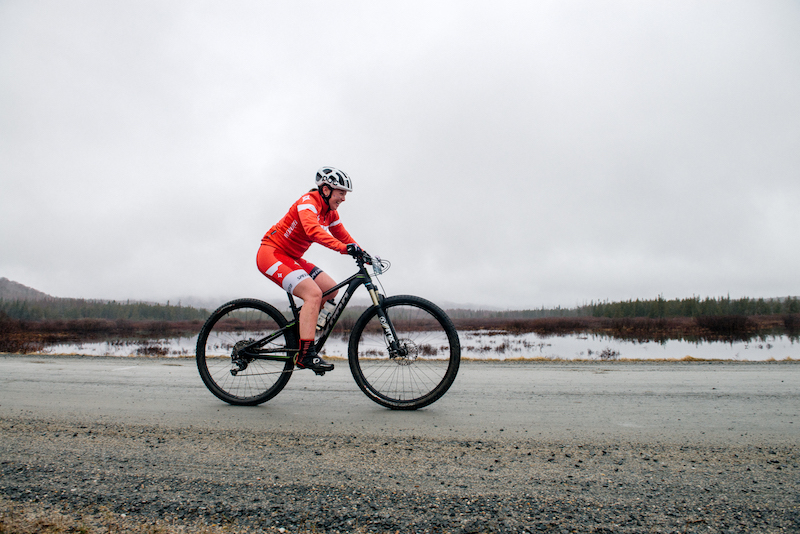
What exactly changed? Barton saw beyond the competition of sport and began to understand its true nature: fun. “The Vermont spirit came out,” she explained. “I don’t have to try to be this perfect triathlete, where your kit is perfect, you’re always aero, and you’ve got your nutrition dialed. All of a sudden, this pressure was kind of gone.” She bought a gravel bike and now spends her free time riding dirt roads with friends. There are probably thousands of stories like Barton’s, the rapid coalescing of a new tribe of laid-back dirt bikers, just in it for the adventure.
Gravel Explosion
Vermont is chock-full of organized rides tapping into that spirit. They have rugged names like the “Overland,” the “Ranger,” the “Raid Lamoille,” and the “Irreverent.” Last year, Myers and Moccia introduced an event with a gentler name: Redemption. It was still plenty hard—100 miles and 9,000-feet of climbing—but it was held on Labor Day weekend on a warm, sunny day. The good weather perhaps gave Rasputitsa riders an opportunity to redeem themselves from the mud-spattered misery of April.
This year, Redemption will come in the form of a gravel stage race: three days of riding, based at the Old Stone House Museum in Brownington from August 30 to September 2. The Old Stone House was a boarding school opened by Alexander Twilight, the first African-American to earn a college degree in the United States (Middlebury, 1823). The building’s massive granite stones were pulled from farmers’ fields nearby, and while the school is no longer in operation, the landscape probably doesn’t look much different than it did in 1836 when the school was completed. Gravel roads bisect dairy farms and fields of hay and corn, and sometimes they narrow into two-rut paths through the forest, where you can imagine horses pulling carriages 150 years ago. “It’s the epitome of natural, rural Vermont,” Moccia said, “and a perfect setting for a gravel event.”

The Redemption Gravel Stage Race will benefit the Davis Phinney Foundation, a non-profit dedicated to helping people with Parkinson’s disease. Phinney is one of the best cyclists in U.S. history—his palmares include two stage wins at the Tour de France—and Parkinson’s hit him at age 40. He created the foundation to help people living with the neurodegenerative disease cope with its many challenges, such as tremors, rigidity, postural instability and depression.
That mission is especially relevant to Myers, who was diagnosed with Parkinson’s three years ago, at the age of 37. At first it affected her ability to use a pen, but as the disease progressed it froze her shoulder in place, making it nearly impossible to ride a bike. As if the physical effects of the disease aren’t bad enough, it has altered her brain chemistry such that her body doesn’t produce dopamine, a neurotransmitter that, among other things, allows a person to feel happy. She’s not one to feel sorry for herself, but the chemical reality in her head was sending her into deep depression. For more than a month, she woke up crying every day. Her relationships suffered. Recently, her doctors have figured out the right dopamine replacement treatment, and she’s happier than she’s been in 10 years.
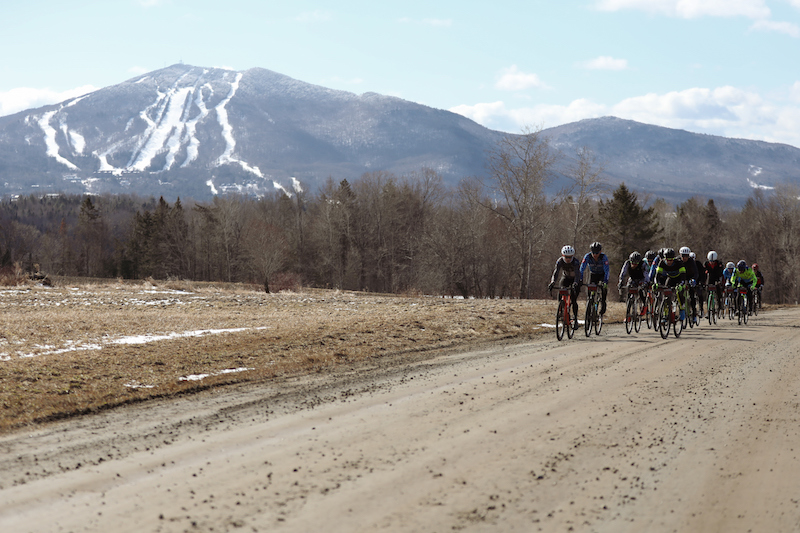
But there is no cure for Parkinson’s. There’s not even a treatment plan. Instead, Myers deals with it by organizing Rasputitsa and Redemption. She and Moccia, true to the nature of gravel, have a lot of fun with it. Last year, their entire marketing and social media campaign revolved around a David Bowie theme. This year, Prince is the reigning gravel rocker. They both have spouses and multiple children, so the events have become something of a family business—even though the proceeds go to charity (Rasputitsa benefits Little Bellas, which gets girls on mountain bikes). “Sometimes it’s pretty easy to wrap myself up in this bubble and play the victim, and I hate doing that,” Myers said. “Knowing that I have to make 1,500 people happy in April is a good distraction.”
As it happens, the race serves as a good distraction for riders, too. There’s not a whole lot of cell phone coverage in the Northeast Kingdom—Vermont Governor George Aiken’s nickname for this roughly 2,000-square-mile expanse of pristine woods, mountains and bogs. Wi-fi is sparse. Intentionally or not, the area is the definition of underdeveloped. And that’s what makes it special. In everyday life, our phones are dinging constantly, our email inbox demands attention, social media begs us to write advertisements for ourselves. But for one hard day, maybe even the whole weekend, a small town’s worth of bike riders can focus on seeing their friends, dialing in their bikes, and getting a dose of the mad, unforgiving beauty of Vermont in spring. That’s a vital part of the experience for Lisa Barton, who puts in long hours working for an office furniture firm. Business is good and she’s driving all the time, working, talking. The dirt roads of the Northeast Kingdom are more than roads, they are invitations to disconnect. “Let’s go play in the woods, where there’s no signal,” she said. “There’s something so refreshing about that.”
Kirk Kardashian lives in Woodstock and writes for a number of national magazines. He also races bikes.
Featured Photo Caption: April can be the cruelest month, but for Magnus Sheffield and Vermonters Ansel Dickey (middle) and former World Tour rider Ted King (right, in the gray Velocio kit), that’s what makes it fun. Photo by Meg McMahon

